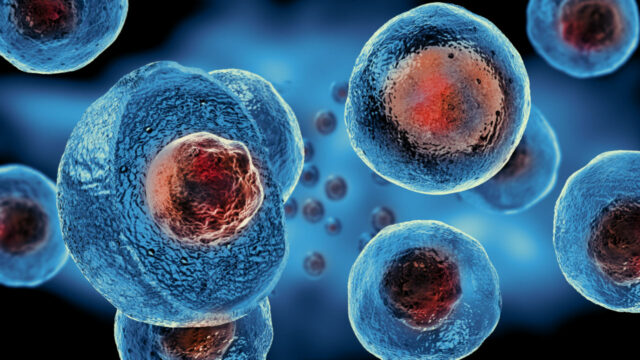
Xintela highlights the unique properties of XSTEM
Biopharma company Xintela develops stem cell products with therapeutic properties aiming to treat diseases that currently lack effective treatment options. The company´s stem cells stand out from others through a selection step in the production process that provides quality-assured, homogenous and pure stem cell preparations. BioStock talked to Lucienne Vonk, Director Musculoskeletal Diseases at Xintela, about the benefits of the company’s stem cell products.
Biopharma company Xintela develops the stem cell products XSTEM, for the treatment of osteoarthritis and difficult-to-heal leg ulcers in humans, and EQSTEM for the treatment of joint diseases in horses.
The company’s research and development are based on the cell surface marker integrin α10β1, which was discovered in the 90s by Xintela’s CEO Evy Lundgren-Åkerlund and her research group at Lund University.
Mesenchymal stem cells with therapeutic properties
Xintela’s stem cell products consist of mesenchymal stem cells (MSCs), a type of multipotent cell that can differentiate into a variety of cell types, such as cartilage cells.
Stem cells have the capacity to regenerate damaged tissues and organs, and stimulate cells in damaged tissue to repair the damage. MSCs can also signal immune cells and have anti-inflammatory effects.
Stem cells from adult donors
Xintela develops stem cell-based treatments from donors (allogeneic) stem cells from donated adipose tissue from healthy adults. Stem cells from one donor can be used to treat many patients, which is more cost-effective than using the patient’s own stem cells.
Pure stem cell preparations by selection
However, stem cell preparations from tissues are often heterogeneous, meaning they are contaminated with other cell types. In addition, stem cell preparations may differ from donor to donor. This can create both regulatory and functional problems.
Xintela’s solution is to purify stem cells using an antibody that binds the company’s stem cell marker, integrin α10β1. The selection means that Xintela receives pure and homogeneous stem cell preparations of high quality that are reproducible between donors.
Focus on knee osteoarthritis and difficult-to-heal leg ulcers
Xintela is conducting two clinical studies with XSTEM; one in patients with knee osteoarthritis and the other for difficult-to-heal leg ulcers. The patient recruitment is ongoing in the phase I/IIa leg ulcer study and the third and last dose level has started in the phase I/IIa osteoarthritis study. The goal is to present safety and preliminary efficacy data from both studies in 2023.
Osteoarthritis is a joint disease associated with the breakdown of cartilage, severe pain and impaired mobility. Standard treatment typically involves relieving the symptoms and as a final option replacing the degenerated osteoarthritis joint with a prosthesis.
Xintela expect that the stem cell product XSTEM will lead to reduced pain and improvement the of the joint function. Previous results from the company’s preclinical studies also suggest that XSTEM is a disease-modifying treatment that can regenerate damaged articular cartilage. Learn more.
Xintela’s Director Musculoskeletal Diseases comments

BioStock contacted Lucienne Vonk, Director Musculoskeletal Diseases at Xintela, to find out more about the benefits of Xintela’s stem cell technology and the competition in the field.
First, could you give us a more detailed explanation of how Xintela’s selection of stem cells is conducted?
– For the selection of the stem cells, we use magnetic beads that are coated with an antibody that binds the company’s stem cell marker, integrin α10β1. The stem cells have integrin α10β1, like a flag, on their cell surface. The magnetic beads will bind to these flags and then, by using a magnet, we can select the stem cells from other cells that do not have the marker on the surface and are thus washed away. After this step, the selected homogenous stem cells population is further expanded in bioreactors to generate the stem cell product XSTEM.
What are the main benefits of the selection technology?
– The main benefit is that the selection generates a homogenous and high-quality stem cell product that can meet the regulatory requirements of identity, purity and potency and that is very consistent between different donors.
– A stem cell preparation without stem cell selection is heterogenous and contains more or less contaminating cells, such as epithelial cells, endothelial cells and fibroblasts. These contaminating cells can have a negative impact on the safety and the therapeutic effects of the stem cell preparation. In addition, since the number of contaminating cells varies between each preparation, it is difficult to give the product a clear identity and to control the therapeutical effect.
– With our selection technology, we can control the stem cell preparations and ensure quality and therapeutic effect of the products. In addition to our selection technology, we also manufacture our cell product in our own GMP-certified facility. Together, these allow us to maintain full control over both the production process and the final cell product.
»With our selection technology, we can control the stem cell preparations and ensure quality and therapeutic effect of the products. In addition to our selection technology, we also manufacture our cell product in our own GMP-certified facility. Together, these allow us to maintain full control over both the production process and the final cell product.«
Why are you using donor (allogeneic) stem cells instead of autologous and/or genetically modified stem cells?
– There are several advantages of using allogeneic instead of autologous stem cells. First of all, it is only possible to offer a true single-stage, off-the-shelf, stem cell therapy with allogeneic cells. For autologous stem cells, patients first need to undergo a primary procedure to harvest tissue (such as adipose or bone marrow) from which the stem cells can be isolated, and culture expanded. Using allogeneic cells also omits a procedure at another (not the affected) location in the body, that could lead to damage at the harvest location such as an infection (donor site morbidity).
– Furthermore, since allogenic stem cells, like XSTEM, can be stored in the freezer in the clinic the patients can be directly treated and start their rehabilitation without going through the procedure to collect the autologous tissue and culture of the cells. Another advantage of using allogeneic cells is the reduced treatment cost per patient as several thousands of patients can be treated with stem cells from one donor. In addition, donors and cells with the highest quality and therapeutic effects can be selected.
»Furthermore, since allogenic stem cells, like XSTEM, can be stored in the freezer in the clinic the patients can be directly treated and start their rehabilitation without going through the procedure to collect the autologous tissue and culture of the cells. Another advantage of using allogeneic cells is the reduced treatment cost per patient as several thousands of patients can be treated with stem cells from one donor.«
– The advantages of allogeneic mesenchymal stem cells over genetically modified stem cells are that the risk of genetic instability is very low as clinically relevant numbers of cells can be reached with a relatively short cell culture expansion, while genetically modified stem cells are usually exhaustively expanded. Further, allogeneic tissue derived stem cells can also home to the site of damage and differentiate into several cell types and act immunomodulatory and anti-inflammatory. So, they have the potential to treat a wide range of diseases without the need for pre-differentiation, while genetically modified stem cells need to be fully differentiated before administration into the body, as they can otherwise form teratoma (tumors that contain different types of tissue).
– So far, tissue derived mesenchymal stem cells such as stem cells from adipose tissue, are the most used type of stem cell in clinical studies and therefore they are already extensively tested for safety.
Are other stem cell companies using a similar technology as Xintela?
– There are several companies working on allogeneic stem cell-based treatments for osteoarthritis. For example Stempeucel (Stempeutics, India) is undergoing phase III studies, CYP-004 (Cynata, Australia) which is in phase III studies, AlloJoin (CBMG, China) which is in phase II and Progenza (Regeneus, Australia) which is in phase II. Furthermore, Cartistem, which is developed by Medipost, has market approval in South Korea. However, none of these companies use a cell-selection in their production process.
There are already clinics that use mesenchymal stem cells from adipose tissue for the treatment of osteoarthritis. In what way is Xintela’s stem cell treatment different to these?
– There are clinics that use minimally manipulated tissue products, but those are not mesenchymal stem cell products. The minimally manipulated tissues are for instance bone marrow, concentrated bone marrow, or the stromal vascular fraction of adipose tissue. Only a very small percentage of the cells in these products are mesenchymal stem cells (0.001% to 0.01% in bone marrow and bone marrow concentrate, 1% to 4% in the stromal vascular fraction of adipose tissue). Thus these products should not be called “stem cells”. Especially in the USA, the Food and Drug Administration (FDA) is very strict with this terminology.
»There are clinics that use minimally manipulated tissue products, but those are not mesenchymal stem cell products. The minimally manipulated tissues are for instance bone marrow, concentrated bone marrow, or the stromal vascular fraction of adipose tissue. Only a very small percentage of the cells in these products are mesenchymal stem cells«
– Also, these minimally manipulated tissue products are less strictly regulated, but only if they are intended for homologous use, meaning to perform the same basic function as they did before administration. These products are not considered drug products and therefore no safety and efficacy studies or quality tests are required, they cannot be marketed and sold as medicinal product, and thus they are usually not covered by healthcare insurance. Xintela´s stem cell products are regulated as advanced therapy medicinal product (ATMP). ATMPs are required to possess proven safety and efficacy, each product is quality tested and they can be covered by healthcare insurance and thereby become available for everybody.
The content of BioStock’s news and analyses is independent but the work of BioStock is to a certain degree financed by life science companies. The above article concerns a company from which BioStock has received financing.

